Different locks explained Part 4
Having looked at the locking barrels for double glazed doors in my previous blog, this blog is dedicated to the actual locking mechanisms themselves. There are several different ways in which they work.
The first and most basic is called a roller;
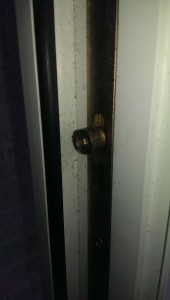
When the door closes and you lift the handles, it simply rolls into position behind a keep that sits on your door frame and looks like this.
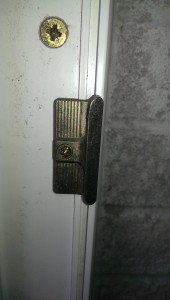
Very few doors only have rollers on their own nowadays as they are incredibly easy to bypass. Their main purpose is to hold the door a bit tighter when closed to stop draughts and they might be the only option on small doors. They are harder to bypass on smaller doors. Without giving the reader tips on how to break into a home, I can only suggest that if you have a double glazed door and it only has these rollers holding it in place, you might want to seek advice from your local locksmith to see if alternatives are available.
Over time, these rollers can shift a little in position, making the door difficult to lock and unlock. You can see from this next image that the correct sized allen key (hex key) can be inserted to rotate the roller. A quarter turn should be tried before attempting to lock the door again and if that does not work, then a further quarter turn and so on until you have established the problem is not with the roller or the problem is fixed.
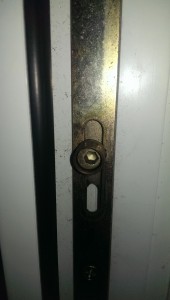
If this does not rectify the problem, it might mean the door has dropped a little and simply moving the keep up or down a few millimetres might do the job, but at this point, I would suggest calling your local locksmith as there could be more serious problems to contend with.
……………………………………………………………………………………………………
A step up from the roller is the mushroom;
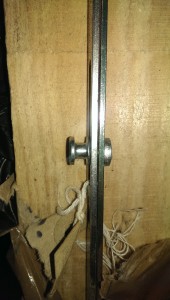
It is more secure than the roller because it slides into a slotted keep where it holds tight. There is nothing to adjust on these mushrooms, so if it causes trouble, and the door cannot be adjusted, the only option is to move the keep accordingly.
……………………………………………………………………………………………………
Next we have hooks and bolts that come out of the mechanism like this:
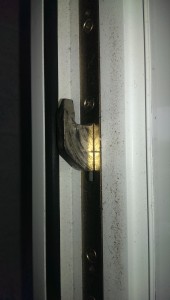
The hooks and bolts themselves do not adjust, but again if the door is out of position, there are adjustments that can be made, this time to the keeps, that look something like this.
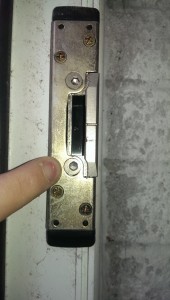
You can see from the picture that an allen key will allow you to adjust this keep. Some only allow backwards and forwards movement, so again, if you are unsure, please call your local locksmith.
Hopefully, you will never have to see behind the scenes of one of these mechanisms, so here is what goes on in the hook case itself.

You can see this one has a hook and bolt. These parts do not often go wrong by themselves, but when they do, the door is extremely difficult to open without damage to either the door itself or the door frame. Therefore basic maintenance is vital and any signs of stiffness when lifting the handles should be dealt with by a professional.
We can now take a look at the gearbox, or centre case, where all main action takes place. There are many brands of these each with differing sizes and shapes within the brand, so this picture is just one example;
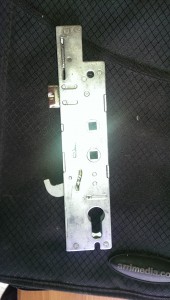
This example is called a double spindle and can be set up in two ways. The standard way is to have both handles operating through this hole.
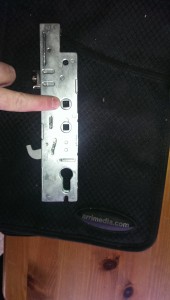
In this case, the door will only be secure when the handles are lifted and the key is turned. However you can have handles where the inside handle operates through the top hole, but the outer handle is slightly lower and goes through this hole
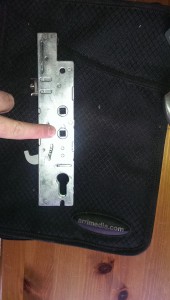
In this case, everything operates exactly the same, but the lower hole does not allow the latch to pull back, meaning that you need the key to get back in. of course, if you are going further than the end of the garden, you should engage the locking mechanism completely as normal, but with this configuration, the door is at least technically secure.
These next two pictures show the hole that the locking barrel slides through and the barrel in place.
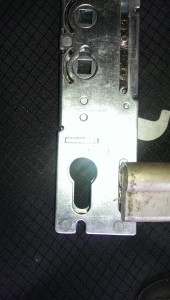
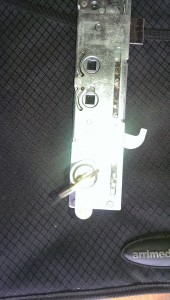
This is the simplest part of the lock. Everything inside above that, however is a minefield of cogs, levers and other moving parts. Please don’t expect your locksmith to be able to open these up and replace inner parts as with so many products around, knowledge of every one would be amazing and the locksmith would need an extra trailer to carry the spares, which would only be second hand as our suppliers do not provide anything other than complete products.
The centre keep for this part, looks something like this.
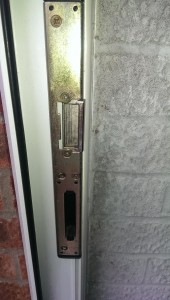
And again, we can adjust certain parts like the latch keep on this one. Loosening these screws, allows the keep to move forwards and backwards.
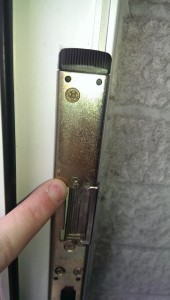
I have come across many problems where simply adjusting this part, which may have moved when someone slammed the door, has rectified the situation. Quite often, the locking mechanism will not operate if the latch is still being pushed in, which it can if this part is in the wrong position.
……………………………………………………………………………………………………
Now, in this blog, I have mentioned doors dropping, which they often do. A sudden gust of wind, stroppy teens slamming, or even direct sunlight warping can all affect how the door sits in the frame.
Most modern upvc doors have hinges that are adjustable. If you have a door with hinges like this;
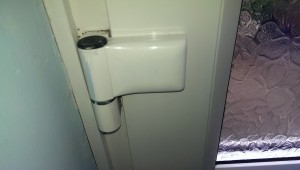
Then there is a good chance the door can be adjusted. The picture shows the one type of hinge that can be a little awkward because you have to prize it apart gently but firmly to get at the adjuster inside. Most actually have a plastic plug easily visible, which when removed, allow access to another allen key adjuster inside. If you are in any doubt, call your local locksmith. But if you feel like taking the job on yourself, half a turn of the adjuster should be all you move before trying to lock the door again. That should be enough to tell you if the door is easier or harder to lock. If harder, then you need to turn the opposite way. Remember, there are anything from two to four hinges that may be adjusted, so this is not an easy job.
Should you have any questions regarding the above information, please do not hesitate to contact me through any of the methods on my contacts page.
Thanks for reading
The first and most basic is called a roller;

When the door closes and you lift the handles, it simply rolls into position behind a keep that sits on your door frame and looks like this.

Very few doors only have rollers on their own nowadays as they are incredibly easy to bypass. Their main purpose is to hold the door a bit tighter when closed to stop draughts and they might be the only option on small doors. They are harder to bypass on smaller doors. Without giving the reader tips on how to break into a home, I can only suggest that if you have a double glazed door and it only has these rollers holding it in place, you might want to seek advice from your local locksmith to see if alternatives are available.
Over time, these rollers can shift a little in position, making the door difficult to lock and unlock. You can see from this next image that the correct sized allen key (hex key) can be inserted to rotate the roller. A quarter turn should be tried before attempting to lock the door again and if that does not work, then a further quarter turn and so on until you have established the problem is not with the roller or the problem is fixed.

If this does not rectify the problem, it might mean the door has dropped a little and simply moving the keep up or down a few millimetres might do the job, but at this point, I would suggest calling your local locksmith as there could be more serious problems to contend with.
……………………………………………………………………………………………………
A step up from the roller is the mushroom;

It is more secure than the roller because it slides into a slotted keep where it holds tight. There is nothing to adjust on these mushrooms, so if it causes trouble, and the door cannot be adjusted, the only option is to move the keep accordingly.
……………………………………………………………………………………………………
Next we have hooks and bolts that come out of the mechanism like this:

The hooks and bolts themselves do not adjust, but again if the door is out of position, there are adjustments that can be made, this time to the keeps, that look something like this.

You can see from the picture that an allen key will allow you to adjust this keep. Some only allow backwards and forwards movement, so again, if you are unsure, please call your local locksmith.
Hopefully, you will never have to see behind the scenes of one of these mechanisms, so here is what goes on in the hook case itself.

You can see this one has a hook and bolt. These parts do not often go wrong by themselves, but when they do, the door is extremely difficult to open without damage to either the door itself or the door frame. Therefore basic maintenance is vital and any signs of stiffness when lifting the handles should be dealt with by a professional.
We can now take a look at the gearbox, or centre case, where all main action takes place. There are many brands of these each with differing sizes and shapes within the brand, so this picture is just one example;

This example is called a double spindle and can be set up in two ways. The standard way is to have both handles operating through this hole.

In this case, the door will only be secure when the handles are lifted and the key is turned. However you can have handles where the inside handle operates through the top hole, but the outer handle is slightly lower and goes through this hole

In this case, everything operates exactly the same, but the lower hole does not allow the latch to pull back, meaning that you need the key to get back in. of course, if you are going further than the end of the garden, you should engage the locking mechanism completely as normal, but with this configuration, the door is at least technically secure.
These next two pictures show the hole that the locking barrel slides through and the barrel in place.


This is the simplest part of the lock. Everything inside above that, however is a minefield of cogs, levers and other moving parts. Please don’t expect your locksmith to be able to open these up and replace inner parts as with so many products around, knowledge of every one would be amazing and the locksmith would need an extra trailer to carry the spares, which would only be second hand as our suppliers do not provide anything other than complete products.
The centre keep for this part, looks something like this.

And again, we can adjust certain parts like the latch keep on this one. Loosening these screws, allows the keep to move forwards and backwards.

I have come across many problems where simply adjusting this part, which may have moved when someone slammed the door, has rectified the situation. Quite often, the locking mechanism will not operate if the latch is still being pushed in, which it can if this part is in the wrong position.
……………………………………………………………………………………………………
Now, in this blog, I have mentioned doors dropping, which they often do. A sudden gust of wind, stroppy teens slamming, or even direct sunlight warping can all affect how the door sits in the frame.
Most modern upvc doors have hinges that are adjustable. If you have a door with hinges like this;

Then there is a good chance the door can be adjusted. The picture shows the one type of hinge that can be a little awkward because you have to prize it apart gently but firmly to get at the adjuster inside. Most actually have a plastic plug easily visible, which when removed, allow access to another allen key adjuster inside. If you are in any doubt, call your local locksmith. But if you feel like taking the job on yourself, half a turn of the adjuster should be all you move before trying to lock the door again. That should be enough to tell you if the door is easier or harder to lock. If harder, then you need to turn the opposite way. Remember, there are anything from two to four hinges that may be adjusted, so this is not an easy job.
Should you have any questions regarding the above information, please do not hesitate to contact me through any of the methods on my contacts page.
Thanks for reading
admin February 3, 2016
